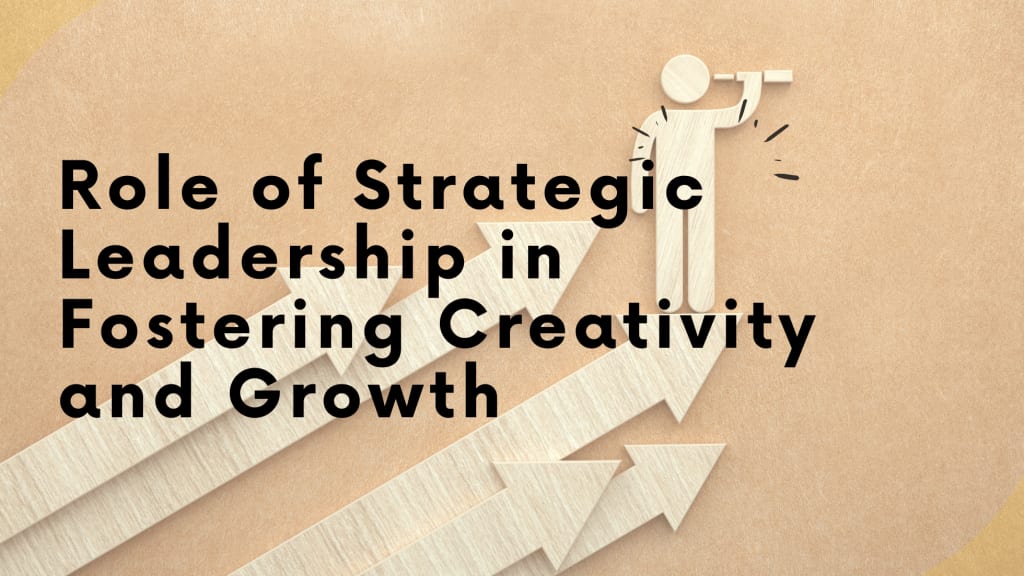Role of Strategic Leadership in Fostering Creativity and Growth
Kevin Kimball explores the role that strategic leadership has in fostering creativity and growth

Effective and strategic leadership is about managing day-to-day operations and inspiring and motivating individuals to think differently, challenge the status quo, and seize new opportunities. It plays an essential role in driving innovation, fostering creativity, and propelling growth in any organization.
While leadership is often associated with making tough decisions and guiding teams toward achieving goals, strategic leadership goes beyond mere management—it involves setting a clear vision, inspiring others, and creating an environment where creativity can thrive. In this article, we'll explore the role of strategic leadership in nurturing creativity and fueling growth within organizations.
Setting a Clear Vision
At the heart of strategic leadership is the ability to set a clear and compelling vision for the future. Leaders must articulate a sense of purpose and direction that inspires and motivates their teams. By communicating a vision that aligns with the organization's values and goals, strategic leaders create a sense of purpose and direction that guides decision-making and fosters unity among team members.
A clear vision serves as a roadmap for innovation, providing a framework for exploring new ideas and pursuing growth opportunities. Strategic leaders empower their teams to think creatively and challenge the status quo, knowing they are working towards a common goal.
Encouraging Innovation
Strategic leaders understand the importance of fostering a culture of innovation within their organizations. They recognize that creativity is the lifeblood of growth and competitive advantage. Leaders create an environment where new ideas can flourish by encouraging experimentation, risk-taking, and open communication.
Strategic leaders foster innovation by empowering employees at all levels to contribute their ideas and insights. They create opportunities for cross-functional collaboration and provide resources and support for exploring new concepts. By fostering a culture of inclusivity and psychological safety, leaders create an environment where diverse perspectives are valued and creativity can thrive.
Leading by Example
Strategic leaders lead by example, demonstrating their commitment to creativity and growth through their actions and behaviors. They model the values and behaviors they want to see in their teams, including openness to new ideas, willingness to take calculated risks, and resilience in the face of challenges.
By demonstrating a growth mindset and embracing continuous learning and development, strategic leaders inspire others to do the same. They encourage their teams to embrace change as an opportunity for growth and innovation rather than a threat to be feared.
Being adaptable
In today's rapidly evolving business landscape, adaptability is essential for success. Strategic leaders understand that change is inevitable and embrace it as an opportunity for growth. They encourage agility and flexibility within their organizations, empowering teams to quickly adapt to new circumstances and capitalize on emerging opportunities.
Strategic leaders also foster a culture of learning and reflection, encouraging their teams to continuously assess their strategies and adjust courses as needed. By staying attuned to market trends, customer needs, and competitive dynamics, leaders can identify emerging opportunities and position their organizations for success.
Being Tech-friendly
Technology is a powerful enabler of innovation and growth in today's digital age. Strategic leaders embrace technology as a tool for driving efficiency, enhancing customer experiences, and unlocking new opportunities for growth. They invest in digital capabilities and empower their teams to leverage technology to streamline processes, gather insights, and deliver value to customers.
Strategic leaders also recognize the importance of staying abreast of emerging technologies and industry trends. By fostering a culture of curiosity and continuous learning, leaders encourage their teams to explore new technologies and experiment with innovative solutions that can propel the organization forward.
Strategic leadership is essential for fostering creativity and driving growth within organizations. By setting a clear vision, encouraging innovation, leading by example, adapting to change, and embracing technology, leaders create an environment where creativity can thrive and new opportunities can be realized. In today's dynamic business landscape, strategic leadership is more critical than ever for unlocking the full potential of individuals and organizations alike.
About the Creator
Kevin Kimball
Kevin Kimball is a business owner and strategic advisor. He owns and operates Game On Travel and Game On Consulting. Visit KevinKimball.info for more info.






Comments
There are no comments for this story
Be the first to respond and start the conversation.